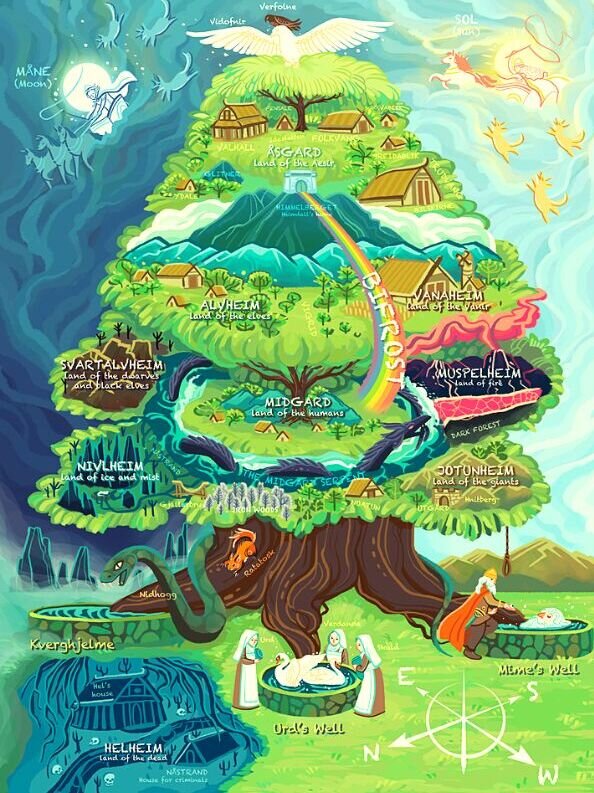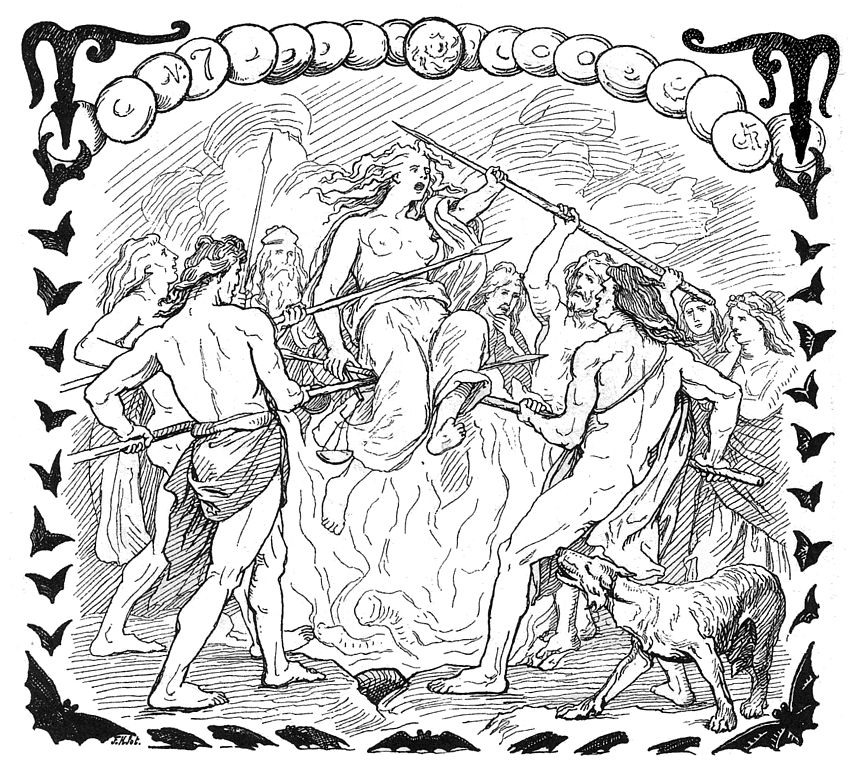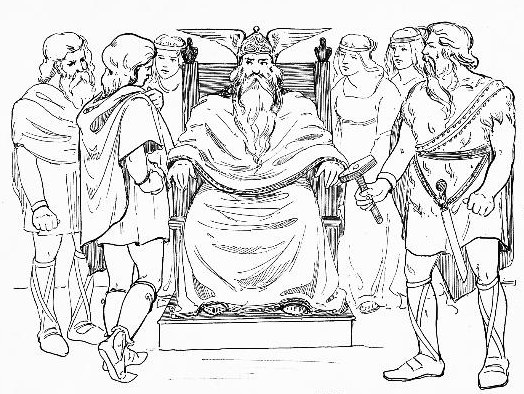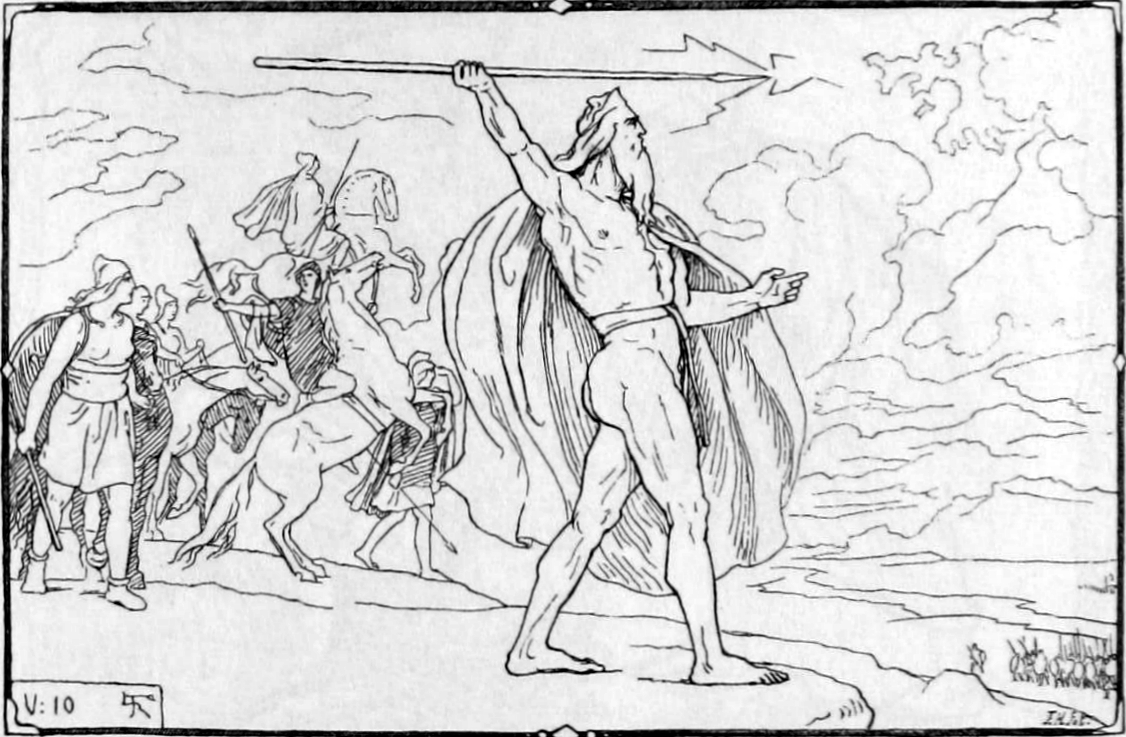In Old Norse mythology, the Æsir–Vanir war was fought between the two groups of gods and goddesses from Asgard and Vanaheim. After a hard-fought conflict, the two sides declared a truce and unified into one pantheon.
In Völuspa, a poem in the Poetic Edda, a völva (or sorceress) recounts the hostilities between the Æsir and the Vanir were the first war between Norse gods the nine realms had seen.
The Difference Between the Æsir and Vanir
The Æsir have more associations with war, influence, and power. The Vanir are gentler and more related to agriculture, magic, and love, in keeping with the pastoral nature of their homeland.
Curiously, the Prose Edda and the Poetic Edda both use “Æsir” to depict male gods in general.
The poem Skírnismál refers to the Vanir Freyr as an Æsir prince. The Prose Edda says his father, Njord, also from Vanaheim, is the third of the Æsir. And it describes Freyja as being second only to Odin’s wife, Frigg, among the Ásynjur (or female Æsir goddesses).

Why Did the Æsir-Vanir War Happen?
Asgard may have invaded Vanaheim over the incestuous practices of the Vanir.
Njord had fathered the Vanir goddess Freyja with his sister, and this incest outraged the Asgardians. Freyja also practiced a form of magic called seiðr, which has associations with effeminacy, something some Asgardians found worthy of mockery.
Loki taunts Odin for his use of the magic in the Lokasenna. These magical practices may also have provoked Asgard into attacking Vanaheim.
You can read some accounts of the conflict in the Völuspá, a poem contained in the Poetic Edda or the Codex Regius, and the Skáldskaparmál, found in the Prose Edda. There is also a record in the 13th-century Ynglinga Saga from Heimskringla by Snorri Sturluson, the Icelandic politician, historian, and poet.
The beginning of the war, as described in The Völuspá
Two stanzas from the Völuspá may indicate that the war started after the Vanir witch Gullveig came to Odin’s Hall in Asgard, was stabbed by spears, and burnt three times, coming back to life on each occasion. On her third reincarnation, she took the identity of Heiðr. Gullveig is depicted as a witch or völva (or seeress – a sorceress and soothsayer) and is often associated with gold.
Gabriel Turville-Petre, John Lindow, and Simek have postulated the theory that Gullveig/Heiðr is the same figure as Freyja.
Subsequent stanzas mention the failure of peace talks between Vanaheim and Asgard and the beginning of the war.

The War Between the Æsir and Vanir Gods
According to chapter four of Heimskringla, a collection of tales about Scandinavian kings, the war was keenly contested, despite Odin assembling a massive army of Asgardians.
The Vanaheim fought fiercely, and conflict raged across Asgard and Vanaheim, with the chapter describing the damage sustained to both lands.
The Result of the War
Eventually, the two sides declared a truce and agreed on an exchange of hostages. According to chapter 23 of Gylfaginning, Vanaheim sent its most important people to Asgard: Njord, Njord’s son Freyr, and Freyja were exchanged for Hœnir, whom the Vanir thought would be a great leader. Asgard also exchanged the sage Mímir for Kvasir, who Sturluson described as the wisest man in Vanaheim.
Hœnir became the king of Vanaheim and appointed Mímir as his advisor. It soon became apparent that the chief could not make any decisions on his own, always answering “let others decide” when asked to make a ruling without Mímir by his side to advise him.
The Vanir felt cheated by the exchange and, rather than making an example of Hœnir, beheaded Mímir instead and sent the head to Asgard.
The introduction of Diar
Odin embalmed the head with herbs and used enchantments to give it the power of speech and reveal Mímir’s secrets. Odin gave Njord and Freyr command of sacrificial customs, and they became known as the Diar (or gods) of Asgard. Freyja was the high priestess of these sacrifices and is credited with introducing seiðr to Asgard.
In a stanza of the poem Vafþrúðnismál, from the Poetic Edda, the jötunn (or giant) Vafþrúðnir said “wise powers” created Njord in Vanaheim and mentioned his exchange as a hostage after the Æsir-Vanir war. Vafþrúðnir also predicts that Njord will return to the “wise Vanir” after Ragnarök (the Norse “end of days”).
The creation of Poetry and Kvasir
In Skáldskaparmál from the Prose Edda, Bragi says poetry first appeared during the war between the Æsir and the Vanir.
During the peace accords at the conflict’s end, the negotiators decided to spit into a vat as a sign of unity. The gods created a wise man called Kvasir from the contents. After Kvasir’s death, his blood was used to form the mead of poetry.
What Are Asgard and Vanaheim Like?
Norse mythology dictates nine realms sit in the branches or the roots of Yggdrasil, the world tree.
The placement of Vanaheim can vary depending on which map you use. However, Asgard always lies in the highest and central section of Yggdrasil. Vanaheim and Alfheim usually flank it.
Asgard
According to legend, Asgard occupies the heavens. It has as many as 12 different regions, one of which is Valhalla (the halls of warriors who died a glorious death in battle).
The main part of Asgard is, by all accounts, a gigantic fortress. Thor’s palace, Thrudheim; Baldr’s hall, Breidablik; and Heimdall’s home, Himinbjorg (or “Heaven’s Cliffs”), are all in Asgard.
In summary, it is the home of the Æsir gods and slain warriors.

Vanaheim
According to Norse cosmology, Vanaheim is the realm of the Vanir, gods associated with soothsaying, fertility, magic, and wisdom.
Vanaheim is described as where the god Njord (or Njörðr) was born and grew up. Njörðr is primarily associated with the sea but also has links to fishing, wind, crop fertility, and wealth.
Vanaheim is a mystery because no descriptions of the land exist in any known literature. However, Rudolf Simek, producer of some notable works on Norse mythology, believed it suited perfectly to agriculture and fishing.
He wrote:
The Vanir are in particular fertility gods who were called upon for good harvests, sun, rain, and good winds especially by the agrarian population, and for favorable weather conditions by the seafarers and fishermen.
Nine Realms of Norse Cosmology – World History Encyclopedia

